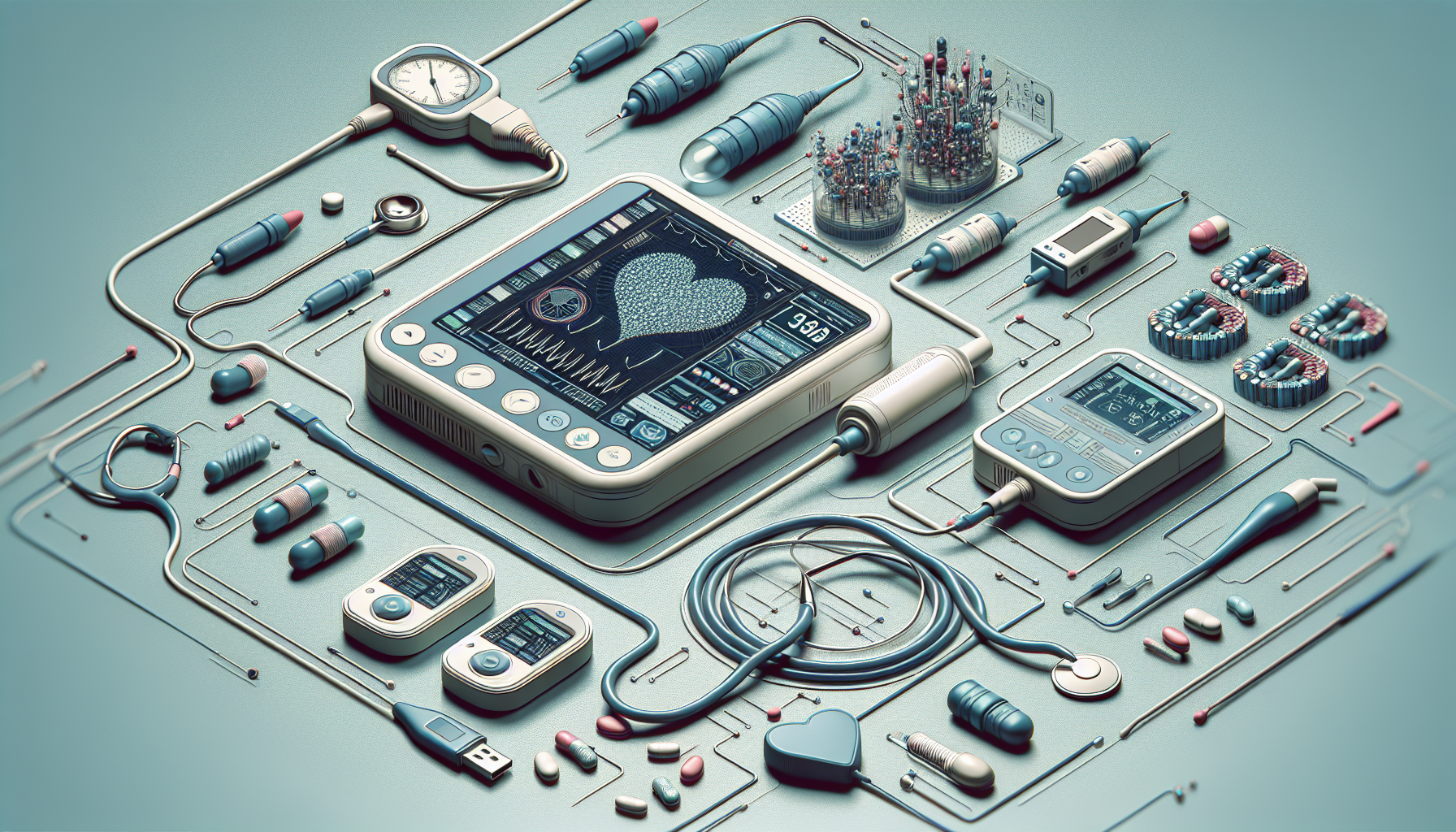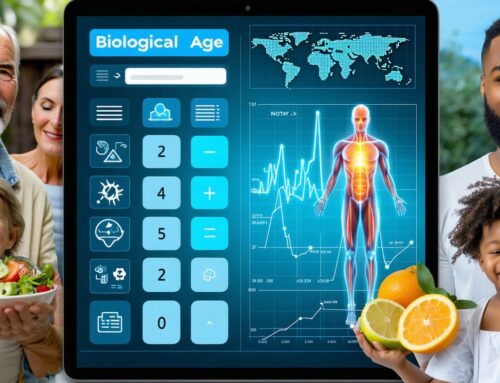Understanding Health Monitoring Devices
Evolution of Wearable Technology
Wearable health tech gadgets weren’t always the high-tech wonders we carry around today. They started as humble step counters and have morphed into sophisticated gizmos that practically turn you into your own personal health lab. These clever companions now give you real-time data on everything from your heart’s BPM to your beauty sleep stats. They’re making checking your health as easy as a quick glance at your wrist Health Information Technology.
The Beginning: Early Wearables
Back in the day, wearables were all about counting your steps. Picture this: the 1920s brought us pedometers, those funny little devices that made you feel good for just walking to the fridge and back. They were simple and nudged you to hit your daily step goals—no judgment if that fridge walk was a significant portion of your daily count.
| Device | Introduction Year | Primary Function |
|---|---|---|
| Pedometer | 1920s | Step Counting |
| Heart Rate Monitors | 1970s | Heart Rate Tracking |
The Shift: Fitness Trackers to Smart Health Monitors
Zoom into the early 2000s, and the world meets fitness trackers. Remember how everyone had a Fitbit bragging about sleep patterns and counting calories? Those were the days when tracking more than just steps was revolutionary. It was like we suddenly cared about how little we actually slept.
Things escalated quickly. In waltzed smartwatches, the tech-wizards on your wrist. Apple and Samsung turned health monitoring into something truly impressive with features like ECG monitoring and blood oxygen measurement. Suddenly, your wrist wasn’t just a wrist—it was a health powerhouse.
| Device | Features | Example |
|---|---|---|
| Fitness Tracker | Steps, Sleep, Heart Rate | Fitbit, Garmin |
| Smartwatch | ECG, Blood Oxygen | Apple Watch, Samsung Galaxy |
Advanced Sensors: Real-time Health Monitoring
This is where things get super fascinating. Wearable sensors can now track vitals in real-time, offering insights into anything from heart flutters to respiratory wheezes Health Wearable Technology. It’s like having a doctor on your wrist whispering sage advice about your health.
Some folks were skeptical at first, but now these gadgets have stepped into precision medicine territory, doing things once thought impossible. What used to be the domain of hospital machines is now wearable, helping catch issues early and tailor treatments to you Wearable Sensors.
The Role in Rehabilitation
Now here’s something golden—wearables aren’t just for health nuts anymore. They’ve found a place in rehab, making a real difference for athletes and folks with disabilities. These marvels of tech help out with balance and coordination or even sniffing out potential health problems before they blow up Rehabilitation Wearables.
Want to know more about the gadgets themselves? Slide on over to our section on wearable health monitors. And if you’re all about the nitty-gritty of what these gadgets track, peek at biomarkers for longevity.
| Function | Examples |
|---|---|
| Sports Rehabilitation | Balance & Coordination |
| Cognitive Rehabilitation | Early Diagnosis & Treatment |
| Personalized Treatment Plans | Custom Health Plans |
Wearable health devices have journeyed from keeping track of your steps to being key players in managing health issues. For the curious minds looking ahead, our future of wearable technologies section serves up plenty of nuggets on what’s coming next in this fast-moving field.
Key Players in Health Monitoring
Keeping an eye on your health is now easier than ever, thanks to some nifty devices shaking up how you track and manage your well-being. Let’s chat about two real heavyweights in this scene: Apple and AliveCor.
Apple’s Contribution
Apple has been making waves in health monitoring with its Apple Watch. It’s not just a gadget on your wrist; it’s a mini health assistant for tech lovers everywhere.
What’s Special About the Apple Watch?
- Heart Rate Buzzer: Gives you a heads-up when your heart’s racing like you’re running a marathon or chillin’ too much.
- ECG Magic: Whip up an ECG anytime, anywhere – a lifesaver for those keeping tabs on their ticker.
- Fall Alert: Perfect for the older folks, it knows when you’ve taken a tumble and can yell for help.
These features have put the Apple Watch front and center in the world of wearables. Curious about how Apple tech cozies up to your personal health routine? Peek at our article on personalized health monitoring.
| Feature | Description | Target Audience |
|---|---|---|
| Heart Rate Notifications | Alerts on unusual heart action | Everyday Users |
| ECG App | Heart health check-ins | Folks watching their heart |
| Fall Detection | Sends help for stumbles | Seniors |
Innovations from AliveCor
AliveCor’s been shaking things up with its cutting-edge gadgets, like the KardiaMobile, blazing new trails in heart health monitoring.
What Makes KardiaMobile Cool?
- ECG-on-the-Go: Slap it on your phone for quick heart checks, right in your pocket.
- Data Sharing: Shoot your heart data to an app, so your doc’s always in the loop.
- Easy Peasy Design: Small, simple, and a breeze to use – great for frequent heart checkers.
AliveCor’s KardiaMobile is a go-to for reliable heart tracking, a top pick for anyone who likes keeping close tabs on their heart beats.
Wondering what’s next? Check out our write-up on advanced biomarker tracking.
| Feature | Description | Target Audience |
|---|---|---|
| ECG Monitoring | Handy heart activity check | Heart-conscious folks |
| Data Transmission | Keep your doc updated | Tech-savvy peeps |
| User-friendly Design | Simple and handy | Everyone |
Both Apple and AliveCor have stuck their flags in the ground as leaders in self-monitoring health devices, giving you the gear to call the shots on your health journey. Dive into what’s next for these gadgets and their role in keeping us healthy.
Remote Patient Monitoring
Benefits of Remote Monitoring
Imagine having a little helper on your wrist or in your pocket that keeps tabs on your health without you having to do a thing. That’s remote patient monitoring (RPM) for you. If you’re juggling chronic conditions, these gadgets can be your new best friends. They’re clever little devices that track your vitals and symptoms as they happen, helping you make smart choices about your health. It’s like having your health partner right there, cheering you on to better well-being. Things like wearable health monitors give you real-time updates on what’s going on in your body – how much you move, how you sleep, and a whole lot more. You’re not just a number in the doctor’s files anymore; you’re calling the shots (Ominext).
Here’s why they rock:
- Better Health Results: When dealing with heart issues, strokes, lung problems, or high blood pressure, remote checks help dodge common mistakes, like messing up your meds (NCBI).
- Living Your Best Life: Keeping an eye on symptoms during serious treatments, like chemo, can mean fewer annoying disruptions and improve chances of success, turning a tough time into something you can better manage (PubMed Central).
- Spotting Trouble Early: Wearables are on it, never missing a beat. They pick up even the tiniest change in your health, so sneaky problems get caught early for quick action (Ominext).
Impact on Chronic Diseases
Got ongoing health problems that just won’t quit? Remote monitoring could change the game for you. Gadgets like health monitoring wearables give you up-to-date info on how your body’s doing, which goes a long way in managing stuff. With instant feedback, you know when to switch up the menu, tweak your workouts, or chat with your doctor about your meds (Ominext).
| Condition | Improved Outcomes |
|---|---|
| Heart Failure | Fewer trips to hospital |
| Stroke | Better track of recovery |
| COPD | Smarter symptom handling |
| Asthma | Fewer trigger-related issues |
| Hypertension | Steadier blood pressure |
RPM also gets you more involved in your wellness journey. Instead of feeling like a sidekick in your own health story, you’re steering the ship. You’ll see better results and get to know your condition inside out.
Curious to learn how RPM can help manage chronic conditions? Swing by our section on personalized health monitoring.
Advancements in Medical Technology
These days, health gadgets are no longer just fancy pedometers that count the steps you take from the couch to the fridge. They’re getting smarter and drastically changing how we buddy up with our doctors. The two biggies of this tech boom: hitching these devices into everyday medical care and cranking up patient safety.
Integration with Clinical Care
Your health devices are basically becoming VIP guest stars in the clinic. They’re streaming real-time health dramas that doctors can binge-watch, helping them dish out top-tier, custom-fit care. Sweet teamwork right there. One partnership makin’ waves is the computerized physician order entry (CPOE) mixing it up with clinical decision support (CDS) systems. Basically, they’re the ultimate no-mistake zone, cutting way down on whoopsies like medication blunders. Some smarty-pants studies claim these bad boys slash the slip-up risk significantly, to 0.46 for medication hiccups and 0.47 for drug slip-ups (NCBI).
| Health IT Systems | Oops-a-daisy in Medication | Oops-a-daisy in Adverse Drug Reactions |
|---|---|---|
| CPOE with CDS | Down 54% | Down 53% |
Way beyond just popping pills right, the superstar show-stealers are wearable gizmos and remote check-up tools. They collect your vitals like a super-spy—blood pressure, sugar levels, oxygen stats—and serve them up to your doctor, adding a heap more accuracy to your personalized care package.
These high-tech tag teams are not just about fixing what’s broke. They’re stepping up the quality of care like never before. We’re talking smart as heck stuff like biomarker assessments and longevity panels that mean we’re catching chronic issues before they even become a problem.
Improving Patient Safety
Let’s chat how tech’s wearing a superhero cape for patient safety by cutting back on meds slip-ups, drug drama, and keeping treatments on the right track. Different tech buddies are doing their safety dance in their own unique flavors.
Those clinical decision peeps—or CDS for short—are superstars in guiding doctors with their digital megaphones, giving tips and setting off little alarm bells here and there. Clever upgrades like ranking importance and quick-alert magic tricks are bumping up how much attention they get from doctors (NCBI).
And then there’s bar code medication administration (BCMA). These bad boys team up with digital drug logs to nearly close the gap on mess-ups by half or even double that in hospital settings! However, they haven’t done a deep dive in pediatrics or when Alice takes her meds home (NCBI).
| Tech Savvy Stuff | Error B-Gone (%) |
|---|---|
| BCMA Systems | 50 – 80 |
Getting all high-tech with health tools isn’t just about safety nets protecting us; they’re like having a personal quarterback in your health game. Wanna jump into this health-tech party? Check out what’s on offer with our lineup of smart health screens and cool gadgets to wear on the go.
These swanky advances in how devices gel with healthcare and make things safer remind us that it’s worth keeping an eye on the latest in health tech. Curious buzzkill? Poke around more on health monitoring awesomeness and cool biometric tests with what we’ve got cooking on our blog.
Remote Monitoring Devices
In the health check scene, remote monitoring gadgets are absolute game-changers for keeping tabs on different health stats right from your couch. Let’s chat about two must-have gadgets: pulse oximeters and glucometers.
Pulse Oximeters
Pulse oximeters are nifty little things that easily attach to a finger or earlobe and keep an eye on your blood oxygen levels (SpO2) and pulse rate. They’re perfect for folks who might struggle with low blood oxygen like those battling Chronic Obstructive Pulmonary Disease (COPD) or heart problems.
With pulse oximeters, you can track your oxygen levels and shoot that info over to your doc for ongoing care. This real-time update is super handy when dealing with troubles like COPD, Congestive Heart Failure (CHF), COVID-19, or asthma.
| Condition | Typical SpO2 Range |
|---|---|
| Healthy Folks | 95-100% |
| COPD | 88-92% |
| Heart Stayed | Varies |
| Mild COVID-19 | 90-94% |
Wanna know more about using a pulse oximeter like a pro? Check out our piece on self-monitoring health devices.
Glucometers
Glucometers are lifesavers for anyone with diabetes or folks keeping an eye on blood sugar for a healthier life. This handy tool measures the glucose level in your blood, nudging you to keep those sugar spikes in check. With instant feedback, glucometers let you make smart choices about food and lifestyle.
These days, glucometers are getting fancy with stuff like Bluetooth, making it a breeze to share info with your healthcare provider. This steady stream of updates helps your doc tweak your treatment plan in time to prevent diabetes-related hassles.
| Time of Test | Ideal Blood Sugar Level (mg/dL) |
|---|---|
| Morning After Fast | 70-100 |
| Before Chow Down | 80-130 |
| 2 Hours Post Meal | < 180 |
Get more tips on weaving glucometers into your day-to-day by visiting our section on continuous health monitoring devices.
Grabbing these remote monitoring tools can amp up your health game by making things easier and spot-on. With gadgets like pulse oximeters and glucometers in your toolkit, you’re paving the way for better health. Dive into more about cool smart health monitoring devices to match your style.
Wearable Health Trackers
Hey there! Time to chat about those nifty gadgets strapped to your wrist! You know, the wearable health trackers? They’ve truly flipped the script on how you can keep tabs on your health. Whether it’s counting steps or measuring heartbeats, these gadgets are your best mate in staying on top of your health game.
Activity Trackers
So, what’s the scoop with activity trackers? They’re like your personal cheerleader; always there to encourage you to move! Devices like Fitbit and the Apple Watch are champions at tracking steps, keeping an eye on that heart rate, evaluating fall risk (watch out, slippery floors!), analyzing sleep patterns, and even checking stress levels. Handy, right?
Here’s a quick peek at what they do:
| Feature | Fitbit | Apple Watch |
|---|---|---|
| Steps | Yes | Yes |
| Heart Rate | Yes | Yes |
| Fall Risk | No | Yes |
| Sleep Tracking | Yes | Yes |
| Blood Pressure | No | Yes |
These trackers keep you in the loop with a live update on your activeness. All this info is a gold mine for making smart health calls and spotting trends that might need a doc’s eye. Wanna know more about how to make the most of these devices? Check out our section on wearable health monitors.
Continuous Monitoring Devices
Now, if you’re ready to step it up a notch, continuous monitoring devices are where it’s at. These gadgets collect non-stop intel on everything from vital signs to sleep habits. It’s like having a personal health assistant that whispers insights just for you. Think continuous glucose monitors (CGMs) – they’re a lifesaver for folks managing diabetes.
Catch a glimpse of how these devices rock:
| Device | Main Function | Key Benefit |
|---|---|---|
| Continuous Glucose Monitor (CGM) | Tracks glucose levels | Manages diabetes |
| Sleep Tracker | Monitors sleep stages | Snooze better |
| Heart Rate Monitor | Keeps a close eye on heartbeats | Detects arrhythmias |
With around-the-clock data, you and your doc can whip up the perfect health plan—great for spotting issues before they snowball. Feeling intrigued? Dive into our article on continuous health monitoring devices.
Wearable trackers are your ticket to taking charge of your health—they turn a boring old task into a fun, interactive journey. Whether you’re counting your steps or checking your sugar levels, these devices make sure you’re in the driver’s seat for your health. Curious to know more? Hop over to our sections on personalized health monitoring and advanced biomarker tracking. Keep moving, stay healthy!
Privacy Concerns in Telehealth
Risks in Telehealth Systems
When you’re diving into the realm of health monitoring devices, thinking about privacy risks is something you should definitely keep on your radar. Telehealth systems toss up some challenges when it comes to keeping your information private and secure, which can make both patients and clinicians a bit uneasy.
A big worry is that you don’t always have a grip on how your data gets handled—where it’s going, and what gets done with it. There are moments when your health details could slip through the cracks while being collected, transmitted, or sitting in storage, all because of those pesky hackers and malware bugs that just won’t quit (AMA Journal of Ethics).
Here are some things that might keep you up at night:
- Unauthorized data access: Yeah, hackers might sneak in and peek at sensitive stuff.
- Data misuse: Sometimes it’s not clear how your data’s being shuffled around.
- Storage vulnerabilities: That cloud space or local storage might not be as safe as you thought if encryption’s overlooked.
Sure, the Health Insurance Portability and Accountability Act (HIPAA) and FDA rules throw a safety net, but they don’t always catch everything, leaving some cracks for consumer apps and devices. HIPAA’s shield only covers certain lanes, so some stuff slips through (AMA Journal of Ethics).
Security Measures
To keep trusting telehealth systems, strong security is a must-have. The Federal Trade Commission (FTC) nudges folks to set up solid privacy and security game plans for telehealth (AMA Journal of Ethics).
Some solid moves to make include:
- Data encryption: This keeps your info safe while it’s traveling or being parked someplace.
- User authentication: Makes sure only the right folks get a peek at your details.
- Regular security audits: These check-ups catch and fix potential security leaks.
- Transparency policies: Lay it all out there on how your data’s being used and shared.
Pulling these tricks out of the hat not only makes things more secure but also builds trust, which is super important for telehealth to really take off. Many people, especially those dealing with chronic stuff, often feel the perks outweigh the jittery bits (AMA Journal of Ethics).
Got an itch to learn more about secure telehealth monitoring tools? Check out our pieces on personalized health monitoring and real-time health monitoring devices.
| Security Measure | Perks |
|---|---|
| Data Encryption | Keeps data safe in transit and at rest |
| User Authentication | Ensures snoopers stay out of your data |
| Security Audits | Spots and plugs security gaps |
| Transparency Policies | Clears up how and where your data is used and shared |
By getting wise to the risks and setting up solid security defenses, you can get the most out of smart health monitoring devices while keeping your private info on the down-low.
Future of Wearable Technologies
Get ready to dive into the exciting world of wearable health gadgets. These nifty little devices are set to become your new best friends on your health and wellness adventure. No kidding, the growth of this industry is going through the roof, with signs pointing to its growing clout in the healthcare game.
Growth and Projections
If you thought smart wearables were just a fad, think again. Back in 2020, the market was worth $13.8 billion, and guess what? By 2028, it’s projected to leap to $37.4 billion. That’s a whole lot of Fitbits and Apple Watches flying off the shelves. This explosion shows that wearable health gadgets are becoming must-haves for anyone wanting to keep tabs on their well-being.
Here’s a look at how things are shaping up:
| Year | Market Valuation ($ Billion) |
|---|---|
| 2020 | 13.8 |
| 2024 (est) | 24.1 |
| 2028 (est) | 37.4 |
People are digging these wearable devices because they’re getting smarter by the day, letting you peek into your health status live. You can now check things like your heart rate, how much oxygen you’re sucking up, and how many steps you’re wading through daily. So the next time your gizmo buzzes, you might, as well thank the tech wizards behind these innovations!
Regulatory Considerations
As wearable tech strides forward, the rules and regs surrounding them are playing catch-up. Keeping folks safe is the name of the game, and the bigwigs are rolling out guidance for how wearables get used in hospitals and clinics. Gizmos like computerized physician order entry (CPOE) systems and clinical decision support (CDS) are already cutting down on the oh-no moments in patient care in a big way.
Table of Regulatory Impacts on Patient Outcomes:
| Technology | Impact on Medication Errors | Impact on Adverse Drug Reactions | Reference |
|---|---|---|---|
| CPOE with CDS | Reduced by 54% | Reduced by 53% | NCBI |
| BCMA Systems | Reduced by 50-80% | Data Limited | NCBI |
Even in clinical trials, wearables are breaking new ground, jazzing up how patients get evaluated and treated. The upshot? A framework that’s gotta focus on understanding just how wearable tech makes a difference in actual care and ensuring it ticks all the regulatory boxes.
When you’re dealing with this whole wearable thing, keep an eye on the tech specs and what the rule-makers have to say. Want to dig into more topics? Check our pieces on personalized health monitoring, continuous health monitoring devices, and real-time health monitoring devices.
By soaking up these growth stats and keeping tabs on how the rulebook’s evolving, you can totally crush it when adding the latest health gadgets to your routine. Keep up with the fast-paced changes and bask in the buzz surrounding top-tier personal healthcare tech!







